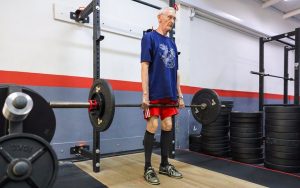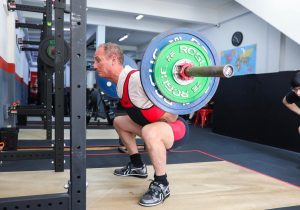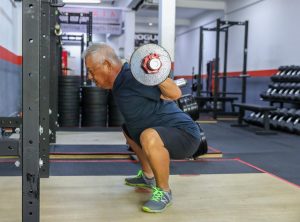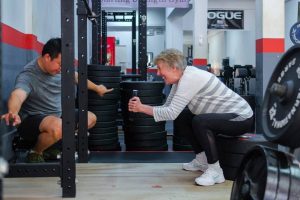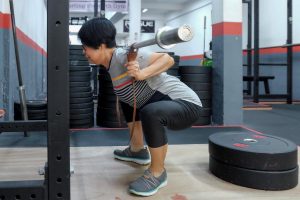Giving a person something that they desperately lack can make a huge difference in that person’s life. A thousand dollars can be life-changing for someone living on the poverty line while a billionaire would likely not bat an eyelid over it. It’s the same for strength – one does not appreciate the role that strength plays in their life until they find themselves in a situation whereby they lack the strength to perform simple activities of daily living.
Things that we take for granted when we’re young becomes a huge task as we get older and lose muscle mass. Simple everyday activities of living – getting up off the floor, walking up a flight of stairs or playing with our grandkids become really tough when we’re not strong enough to do so.
Strength and muscle loss – part of the ageing process
Strength and muscle mass is something that everyone loses as they age – this is an irrefutable fact and occurs whether you like it or not. This process creeps up on you – after age 30, you lose about 3-5% of muscle mass per decade. The general population’s reaction to seeing a loved one getting weaker is to help them avoid doing physical activities. Grandma finding that walking is getting her exhausted? Let’s get her a wheelchair or mobility scooter. Grandpa can’t quite load the groceries into his car? Let’s just get the groceries delivered to his home.
Granted, these actions come from a good place and we’re trying to make life easier for our loved ones. Unfortunately, this is doing them a massive disservice. Lowering the activity level of someone in an already weakened state is a surefire way to accelerate their muscle atrophy. If one does not consistently utilise their muscles to produce sufficient force to ensure that they maintain their ability to do so, the inactivity exacerbates the natural ageing process of muscle atrophy – a double whammy.
Strength – the key to physical independence as an older adult
Getting a weak older adult stronger is like handing the keys to their independence back to them. That’s why I love working with older adults. Sure, it’s pretty cool to work with young guys and get them big and strong. However, nothing beats the satisfaction of making a difference in an older adult’s quality of life. When my 64 year old client tells me that she’s no longer osteoporotic or when my 70 year old client who had a stroke in the past is now capable of standing up from the floor on his own as a result of getting stronger through barbell training – that brings warm feelings to my heart.
What would you do when you’ve found something that gave you your physical independence and quality of life back? Well, you’ll most likely share it with your family and friends so that they can also experience it themselves. Almost all of our older clients, pleased with the difference that their newfound strength has made in their lives, are very keen to share their experience and encourage anyone who is willing (or sometimes unwilling) to listen that they too can and should get stronger.
Unfortunately, their enthusiasm is usually met with loads of pushback when they share that they’re doing barbell strength training. Common comments they’ll get are “That looks so dangerous!” “Should you be lifting that much weight?” “Do be careful or you’ll hurt your knees/back” or “Oh, I can’t do that because I have (insert injury here)”. These comments usually stem from misinformation, a lack of understanding and/or bad experiences with barbell training.
There are many modalities that one can utilise to get stronger but barbell training is by far the best tool to get strong, bar none (a little pun intended). The case for barbells being the best tool for getting strong has been written about extensively and is outside the scope of this article.
I’m old, have aches, pains and injuries. Can I still train?
The common perception about “barbell strength training” is that it’s about strong young males lifting heavy weights and not something that older adults should engage in. If you’re an older adult and if you didn’t spend your whole life sitting in a chair and being overly cautious, you’ll probably have collected some “life experiences” along the way – aches, pains and probably some injuries. If you somehow managed to get through without any injuries, you’ll still have to deal with this little thing called degeneration – another unavoidable process. Can older adults with “life experiences” train safely with barbells and realise the benefits that barbell training provides? Most definitely so – we see it all the time here at the gym.
When you first come in to train, we’ll start off with a chat and you’ll fill out a questionnaire so that we’re up to speed on your physical condition. Once we have a better understanding of your current condition, we will be cognizant of your limitations and/or any injuries.
We know that the barbell lifts that will give you the most bang for your buck would be the four main lifts – squat, press, deadlift and bench press. However, we also understand that you may not initially be able to perform these lifts as prescribed either due to an injury and/or lack of strength. The end goal is to get you strong performing these lifts as prescribed or as close to it as possible within their capabilities.
What if I’m not strong enough to do the lifts?
The first lift that you’ll start off with is the squat so let’s use that as an example of how you’ll start squatting when you first start training. What you don’t realise (now that you will after you read this) is that we’re observing you from the moment you step into the gym. We’re observing how you walk, sit and stand. Using these observations, we can get a rough sense of where you are physically and can gauge if you possess the strength to squat down to proper depth (hip crease below the top of the patella) and stand back up. If we suspect that you might not be able to stand back up, we’ll start off with box squats. While we might be wrong and you indeed able to squat down stand up back up, it’s better to have the box and not need it than to need the box and not have it.
Just imagine that if you squat down and can’t get back up. Either you’ll fall to the ground or you’ll have to be helped up. Both ain’t good and may result in the you being embarrassed, disheartened and not wanting to carry on training, which is a real bummer because you’ll miss out on what being stronger can do for you (ask me how I know). Once again, let me emphasise that it’s always good to err on the side of caution.
After talking to you about the squat, we’ll start practising the lift by first stacking a bunch of plates for your first box squat. We’ll instruct you to squat down till your butt contacts the plates and then to immediately stand back up, while making sure that you don’t fully rest at the bottom. This is to ensure that you don’t relax at the bottom of the squat so that it’s one less thing to worry about when you transition to a “normal” squat.
Starting with a high stack of plates, we’ll slowly lower the height every set till we reach an appropriate height – challenging for you but still being able to maintain good technique (Fig. 1). The end goal of box squats is to slowly lower the height of the box over time so that you can eventually squat to the proper depth and stand back up without the box. Once you are is strong enough to do that, we’ll gradually start to add load.
When we say add load, we don’t mean immediately placing a 20kg barbell on your back and telling them to squat it. We have speciality bars weighing as little as 5kgs that can be used to start with. What if 5kg is still too heavy to start with? In this case, you can hold a 1.25kg weight plate in their hands and squat and slowly increase the weight over time until you are able to squat 5kg.
Fig. 1
I can’t squat with a barbell on my back. My shoulders don’t allow it.
Now, what if you are able to squat to proper depth on Day 1 but lack the shoulder flexibility to perform the squat that we prefer, the low bar back squat? The preference for the low bar back squat has also been written about extensively and is outside the scope of this article. Older adults, especially older men, have a higher incidence of shoulder flexibility issues and tend to struggle to get the barbell in the low bar position.
When we encounter this, we first need to establish what’s causing the inflexibility – is it a structural issue or a strength issue? If it’s a structural issue, nothing non-invasive can help so we need to work around the issue. The first alternative that we use is a high bar back squat, whereby the bar sits up on the upper trapezius.
Most people can get into this position relatively easily, although it may be slightly uncomfortable at the start for some. For others, even a high bar position challenges their shoulder flexibility. In this case, a safety squat bar may be used so that their shoulders are flexed – instead of being abducted and medially rotated – a much easier position to assume. One problem, however, is that safety squat bars are usually way too heavy to start with. This issue can be overcome with a simple solution – the 5kg bar can be made to mimic a safety squat bar by using wrist straps (Fig. 2). For individuals who do not have structural issues with their shoulders, this modified safety squat bar is a step towards a high bar back squat and eventually (if possible) a low bar back squat.
Fig. 2
This is but a brief outline of how an older adult with aches/pains/injuries and no training experience can get stronger safely using barbell training. If you’re looking to get stronger to improve your health and quality of life, I implore you to give barbell training a go. Rest assured that it doesn’t matter how much weight you lift or what range of motion you’re able to perform on Day 1.
We’ll find an appropriate and safe starting point for you and gradually increase the weights over time. Slowly, but surely, you’ll get stronger and enjoy the benefits that strength brings. One day, as you’re retrieving your luggage from the carousel, it’ll suddenly dawn on you that it’s much easier to do so than it has been in years and you’ll wonder why you didn’t start strength training earlier in your life.
The best time to plant a tree was 20 years ago. The second best time is now. It’s never too late to start training for strength. Make a decision to improve your quality of life and commit to getting stronger today.

